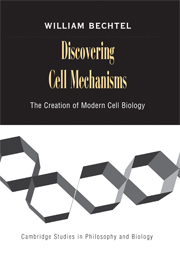Book contents
- Frontmatter
- Contents
- Preface
- 1 Introduction: Cell Mechanisms and Cell Biology
- 2 Explaining Cellular Phenomena through Mechanisms
- 3 The Locus of Cell Mechanisms: Terra Incognita between Cytology and Biochemistry
- 4 Creating New Instruments and Research Techniques for Discovering Cell Mechanisms
- 5 Entering the Terra Incognita between Biochemistry and Cytology: Putting New Research Tools to Work in the 1940s
- 6 New Knowledge: The Mechanisms of the Cytoplasm
- 7 Giving Cell Biology an Institutional Identity
- Afterword
- References
- Index
7 - Giving Cell Biology an Institutional Identity
Published online by Cambridge University Press: 05 June 2012
- Frontmatter
- Contents
- Preface
- 1 Introduction: Cell Mechanisms and Cell Biology
- 2 Explaining Cellular Phenomena through Mechanisms
- 3 The Locus of Cell Mechanisms: Terra Incognita between Cytology and Biochemistry
- 4 Creating New Instruments and Research Techniques for Discovering Cell Mechanisms
- 5 Entering the Terra Incognita between Biochemistry and Cytology: Putting New Research Tools to Work in the 1940s
- 6 New Knowledge: The Mechanisms of the Cytoplasm
- 7 Giving Cell Biology an Institutional Identity
- Afterword
- References
- Index
Summary
In previous chapters I have focused on how new research techniques, especially electron microscopy and cell fractionation, made it possible for researchers to investigate mechanisms within cells. I have analyzed the development of the first products of these investigations – mechanisms for oxidative metabolism in the mitochondria, for protein synthesis in the endoplasmic reticulum, for protein transport in the Golgi apparatus, and for breakdown and disposal of cellular material in the lysosome. These endeavors were the focus of a new field of science that by the 1960s called itself cell biology. Many researchers chose this term intentionally to mark a distinction between classical cytology, concerned primarily with morphological structure, and the new, initially interdisciplinary enterprise that took on the challenge of integrating structural and functional information about the cell. By the end of the 1960s, this new scientific field had successful occupied the terra incognita between cytology and biochemistry I identified in Chapter 3.
To become more than a temporary enterprise, cell biology needed its own institutional identity. Journals and professional societies are among the defining institutions of a scientific discipline. These provide important channels for scientists not only to disseminate their work, but also to receive credit for it. Publishing in a journal or appearing on a scientific program provides stature to scientists and evidence that their work is recognized by peers. Such institutions, though, play more than a certifying role.
- Type
- Chapter
- Information
- Discovering Cell MechanismsThe Creation of Modern Cell Biology, pp. 258 - 278Publisher: Cambridge University PressPrint publication year: 2005



